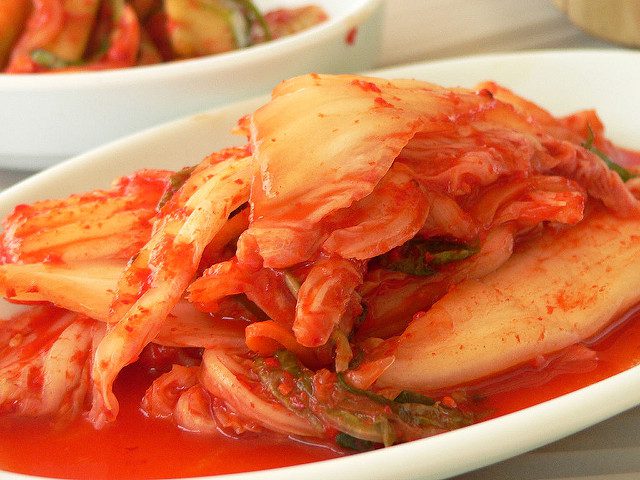With fermented foods hitting near the top of trending foods the last few years, I think it’s time to talk about kimchi (also written “Kim Chee”).
Many people have a love/hate relationship with kimchi. They love the garlicky, spicy, raw freshness of the pickled cabbage, yet have to apologize to their friends for their, well… garlic breath, which seems to also permeate one’s pores.
If you’ve never tried it, but you keep hearing about it, let me enlighten you. Kimchi is a traditional, fermented, Korean side dish made with vegetables—typically cabbage—and a variety of spices. Ranging from mild to extra hot, it’s often used as a condiment and pairs well with Korean barbecue beef and a variety of other Asian flavor profile foods.

Kimchi has been getting a lot of attention lately thanks to the increased interest in foods with “gut”-friendly probiotics. Similar to yogurt, kimchi naturally contains bacteria that are beneficial to the digestive system. And with the ever-growing popularity of Asian flavors, especially Korean food, kimchi is having its moment.
Fermented vegetables… sounds kind of weird, right? It’s actually an extremely old way of preserving foods. Basically, you liberally salt the vegetable and wait for its natural liquids to seep out. Then you keep it submerged in its own juices for months, or longer. With the addition of garlic, ginger, and red pepper, kimchi really packs a flavorful and a healthy punch. Authentic kimchi often contains a dash of fish sauce, or another fish flavoring, which true kimchi aficionados swear by.
One cool thing about kimchi is that even after it’s jarred up, it’s still fermenting a little. When sold at the grocery store, kimchi jars must be kept refrigerated because they can’t be hermetically sealed. Why not? Because the natural gasses released during continuous fermentation would build up and result in a little kimchi volcano—the jar could explode. In fact, when you buy a jar of kimchi, be sure to open it over the sink, as a little eruption of those friendly fermenting bubbles can happen. (Disclosure: Frieda’s has been selling jarred kimchi since 1978 and every few months we get an email from a consumer who lets us know their kimchi keeps bubbling. We have to tell them that’s normal.)
One question we often get is, “How do I make my own kimchi?” While we can’t give out our own secret recipe, we often share a few recipe suggestions from other sources, including “Basic Napa Cabbage Kimchi” from Chowhound. Actually, my favorite kimchi is one made with cucumber. I once ate an entire jar. Try it—you’ll love it!
As I mentioned, kimchi is the kind of food that people either love or hate. And when they love it, some people become a little fanatical about it. Case in point: a Frieda’s kimchi consumer from upstate New York whom we’ve dubbed “Kimchi John.” He started sending us kimchi fan mail a few years ago. He claims ours is the only brand that has the authentic flavor and taste that he wants, and he continues to send us regular updates from his store and his kitchen, including some of the delicious dishes he has cooked up using kimchi. He even has a dedicated album on our company Facebook page—John T’s Kimchi Korner!


I’ve been seeing kimchi popping up on restaurant menus all over the country too. This past weekend, daughter Alex and I dined at one of the top vegetarian restaurants in the country, Gjelina in Venice, California. And what was the first thing we saw on the menu? “Sprouted Purple Barley with KimChee and Thyme.” Yum! You can bet that was the first thing we ordered, and it did not disappoint. The crunch of the kimchi was a nice contrast to the chewy, rich flavor of the sprouted barley. And it was not too garlicky.
As our Western palates become more open to trying new tastes, amazingly flavorful foods like kimchi and gochujang (Korean hot sauce) are finally getting the spotlight. The added bonus is that the fermented nature of the kimchi might even be good for our digestive health.
So, eat your kimchi!
Karen





